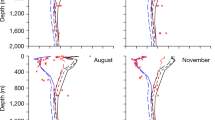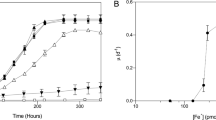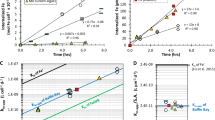Abstract
Iron is a limiting nutrient for primary production in large areas of the oceans1,2,3,4. Dissolved iron(iii) in the upper oceans occurs almost entirely in the form of complexes with strong organic ligands5,6,7 presumed to be of biological origin8,9. Although the importance of organic ligands to aquatic iron cycling is becoming clear, the mechanism by which they are involved in this process remains uncertain. Here we report observations of photochemical reactions involving Fe(iii) bound to siderophores—high-affinity iron(iii) ligands produced by bacteria to facilitate iron acquisition10,11,12. We show that photolysis of Fe(iii)–siderophore complexes leads to the formation of lower-affinity Fe(iii) ligands and the reduction of Fe(iii), increasing the availability of siderophore-bound iron for uptake by planktonic assemblages. These photochemical reactions are mediated by the α-hydroxy acid moiety, a group which has generally been found to be present in the marine siderophores that have been characterized13,14,15. We suggest that Fe(iii)-binding ligands can enhance the photolytic production of reactive iron species in the euphotic zone and so influence iron availability in aquatic systems.
This is a preview of subscription content, access via your institution
Access options
Subscribe to this journal
Receive 51 print issues and online access
$199.00 per year
only $3.90 per issue
Buy this article
- Purchase on Springer Link
- Instant access to full article PDF
Prices may be subject to local taxes which are calculated during checkout




Similar content being viewed by others
References
Martin, J. H. et. al. Testing the iron hypothesis in ecosystems of the equatorial Pacific Ocean. Nature 371, 123–129 (1994).
Coale, K. H. et. al. A massive phytoplankton bloom induced by an ecosystem-scale fertilization experiment in the equatorial Pacific Ocean. Nature 383, 495–501 (1996).
Hutchins, D. A. & Bruland, K. W. Iron-limited diatom growth and Si:N uptake ratios in a coastal upwelling regime. Nature 393, 561–564 (1998).
Boyd, P. W. et. al. A mesoscale phytoplankton bloom in the polar Southern Ocean stimulated by iron fertilization. Nature 407, 695–702 (2000).
Gledhill, M. & Van den Berg, C. M. G. Determination of complexation of iron (III) with natural organic complexing ligands in seawater using cathodic stripping voltammetry. Mar. Chem. 47, 41–54 (1994).
Rue, E. L. & Bruland, K. W. Complexation of iron(III) by natural organic ligands in the Central North Pacific as determined by a new competitive ligand equilibration/adsorptive cathodic stripping voltammetric method. Mar. Chem. 50, 117–138 (1995).
Wu, J. & Luther, G. W. Complexation of Fe(III) by natural organic ligands in the Northwest Atlantic Ocean by a competitive ligand method and a kinetic approach. Mar. Chem. 50, 159–177 (1995).
Hutchins, D. A., Witter, A. E., Butler, A. & Luther, G. W. Competition among marine phytoplankton for different chelated iron species. Nature 400, 858–861 (1999).
Johnson, K. S., Gordon, R. M. & Coale, K. H. What controls dissolved iron concentrations in the world ocean? Mar. Chem. 57, 137–161 (1997).
Trick, C. G. Hydroxamate-siderophore production and utilization by marine eubacteria. Curr. Microbiol. 18, 375–378 (1989).
Wilhelm, S. & Trick, C. G. Iron-limited growth of cyanobacteria: Multiple siderophore production is a common response. Limnol. Oceanogr. 39, 1979–1984 (1994).
Granger, J. & Price, N. M. The importance of siderophores in the iron nutrition of heterotrophic marine bacteria. Limnol. Oceanogr. 44, 541–555 (1999).
Reid, R. T., Live, D. H., Faulkner, D. J. & Butler, A. A siderophore from a marine bacterium with an exceptional ferric ion affinity constant. Nature 366, 455–458 (1993).
Haygood, M. G., Holt, P. D. & Butler, A. Aerobactin production by a planktonic marine Vibrio sp. Limnol. Oceanogr. 38, 1091–1097 (1993).
Martinez, J. S. et al. Self-assembling amphiphilic siderophores from marine bacteria. Science 287, 1245–1247 (2000).
Lewis, B. L. et al. Voltammetric estimation of iron(III) thermodynamic stability constants for catecholate siderophores isolated from marine bacteria and cyanobacteria. Mar. Chem. 50, 179–188 (1995).
Macrellis, H. M., Trick, C. G., Rue, E. L. & Bruland, K. W. Collection and detection of natural iron-binding ligands from seawater. Mar. Chem. (in the press).
Rue, E. L. & Bruland, K. W. The role of organic complexation on ambient iron chemistry in the equatorial Pacific Ocean and the response of a mesoscale iron addition experiment. Limnol. Oceanogr. 42, 901–910 (1997).
Zuo, Y. & Hoigne, J. Formation of hydrogen peroxide and depletion of oxalic acid in atmospheric water by photolysis of iron(III)-oxalato complexes. Environ. Sci. Technol. 26, 1014–1022 (1992).
Faust, B. C. & Zepp, R. G. Photochemistry of aqueous iron(III)-polycarboxylate complexes: Roles in the chemistry of atmospheric and surface waters. Environ. Sci. Technol. 27, 2517–2522 (1993).
Albrecht-Gary, A.-M. & Crumbliss, A. L. in Metal Ions in Biological Systems Vol. 35, Iron Transport and Storage in Microorganisms, Plants, and Animals (eds Sigel, A. & Sigel, H.) 239–327 (Marcel Dekker, New York, 1998).
Wells, M. L., Mayer, L. M., Donard, O. F. X., de Souza Sierra, M. M. & Ackelson, S. G. The photolysis of colloidal iron in the oceans. Nature 353, 248–250 (1991).
Johnson, K. S., Coale, K. H., Elrod, V. A. & Tindale, N. W. Iron photochemistry in seawater from the equatorial Pacific. Mar. Chem. 46, 319–334 (1994).
O'Sullivan, D. W., Hanson, A. K., Miller, W. L. & Kester, D. R. Measurement of Fe(II) in surface water of the equatorial Pacific. Limnol. Oceanogr. 36, 1727–1741 (1991).
Waite, T. D., Szymczak, R., Espey, Q. I. & Furnas, M. J. Diel variations in iron speciation in northern Australian shelf waters. Mar. Chem. 50, 79–91 (1995).
Emmenegger, L., King, D. W., Sigg, L. & Sulzberger, B. Oxidation kinetics of Fe(II) in a eutrophic Swiss lake. Environ. Sci. Technol. 32, 2990–2996 (1998).
Archer, D. E. & Johnson, K. A model of the iron cycle in the ocean. Glob. Biogeochem. Cycles 14, 269–279 (2000).
Marfey, P. Determination of D-amino acids. II. Use of a bifunctional reagent,1,5-difluoro-2,4-dinitrobenzene. Carlsberg. Res. Commun. 49, 591–569 (1984).
Donat, J. R. & Bruland, K. W. Direct determination of dissolved cobalt and nickel in seawater by differential pulse cathodic stripping voltammetry preceded by adsorptive collection of cyclohexane-1,2-dione dioxime complexes. Anal. Chem. 60, 240–244 (1988).
Hudson, R. J. M. & Morel, F. M. M. Distinguishing between extra- and intracellular iron in marine phytoplankton. Limnol. Oceanogr. 34, 1113–1120 (1989).
Acknowledgements
This work was supported by the NSF/DOE Environmental Molecular Science Institute (A.B. and K.W.B.), the National Institutes of Health (A.B.) and the University of California President's postdoctoral fellowship program (K.B.).
Author information
Authors and Affiliations
Corresponding author
Rights and permissions
About this article
Cite this article
Barbeau, K., Rue, E., Bruland, K. et al. Photochemical cycling of iron in the surface ocean mediated by microbial iron(iii)-binding ligands. Nature 413, 409–413 (2001). https://doi.org/10.1038/35096545
Received:
Accepted:
Issue Date:
DOI: https://doi.org/10.1038/35096545
This article is cited by
-
Isolation of dissolved organic matter from aqueous solution by precipitation with FeCl3: mechanisms and significance in environmental perspectives
Scientific Reports (2023)
-
Sources, sinks, and cycling of dissolved organic copper binding ligands in the ocean
Communications Earth & Environment (2022)
-
Siderophores as an iron source for picocyanobacteria in deep chlorophyll maximum layers of the oligotrophic ocean
The ISME Journal (2022)
-
Petrobactin, a siderophore produced by Alteromonas, mediates community iron acquisition in the global ocean
The ISME Journal (2022)
-
Fe(III)-polyuronic acid photochemistry: radical chemistry in natural polysaccharide
Photochemical & Photobiological Sciences (2021)
Comments
By submitting a comment you agree to abide by our Terms and Community Guidelines. If you find something abusive or that does not comply with our terms or guidelines please flag it as inappropriate.



